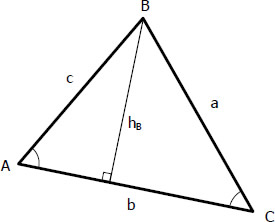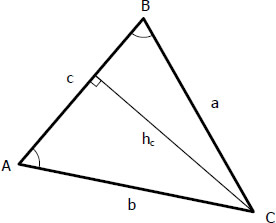Derivation of Sine Law
For any triangles with vertex angles and corresponding opposite sides are A, B, C and a, b, c, respectively, the sine law is given by the formula...
Derivation
To derive the formula, erect an altitude through B and label it hB as shown below. Expressing hB in terms of the side and the sine of the angle will lead to the formula of the sine law.

$\sin A = \dfrac{h_B}{c}$
$h_B = c \sin A$
$\sin C = \dfrac{h_B}{a}$
$h_B = a \sin C$
Equate the two hB's above:
$h_B = h_B$
$c \sin A = a \sin C$
$\dfrac{c}{\sin C} = \dfrac{a}{\sin A}$
To include angle B and side b in the above relationship, construct an altitude through C and label it hC as shown below.

$\sin A = \dfrac{h_C}{b}$
$h_C = b \sin A$
$\sin B = \dfrac{h_C}{a}$
$h_C = a \sin B$
$h_C = h_C$
$b \sin A = a \sin B$
$\dfrac{b}{\sin B} = \dfrac{a}{\sin A}$
Thus,
Therefore, the ratio of one side to the sine of its opposite angle is constant.
Note:
The constant ratio above is the diameter of the circumscribing circle about the triangle. See the proof (not available for now) for this note.
- Log in to post comments
